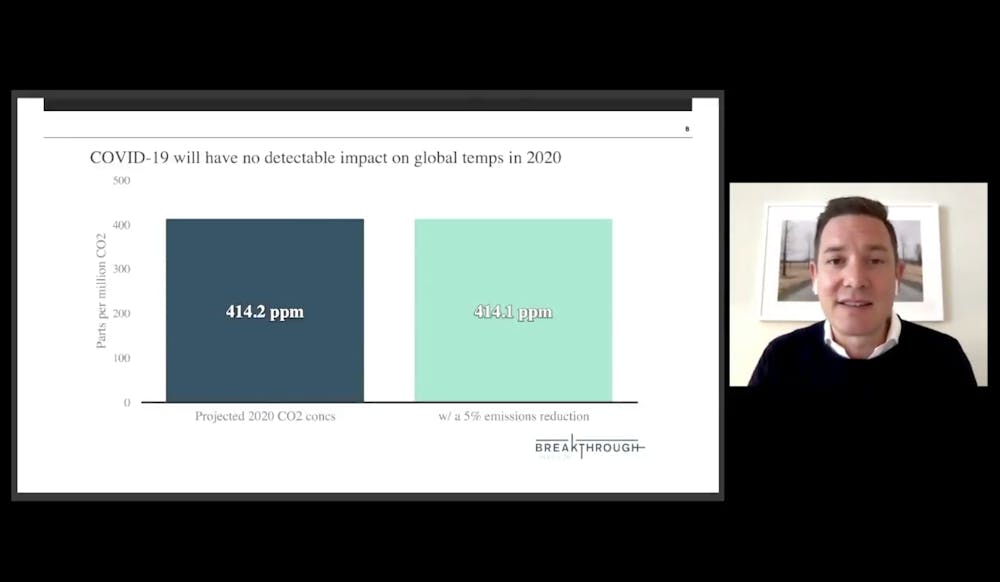Jonas Nahm, an assistant professor at the School of Advanced International Studies, delivered a talk titled “Globalization & Climate Change in the Age of COVID-19” on Sept 15. The talk was part of the Hopkins at Home lecture series.
Nahm recounted being in China in January when the outbreak began. His ongoing research focuses on China’s electric vehicle industry. More broadly, he studies the utilization of clean energy in China, Germany and the U.S.
Once lockdown measures were instituted in China, he observed a drop in carbon emission rates.
“Traffic went down, the air pollution in China rapidly cleared up, global air travel was shut down,” Nahm said. “As these lockdowns spread from China to other parts of the world, there were a lot of conversations about what this might mean for carbon emissions.”
According to the International Energy Agency, global energy demand declined by 3.8 percent in the first quarter of 2020. Oil demand was down nearly five percent, with global road transport activity being 50 percent below the 2019 average and aviation 60 percent below. Electricity demand has also been reduced due to lockdown measures.
While these statistics seem substantial, Nahm warned against undue optimism.
“The emissions reductions are really much smaller than you think. Shutting down much of the global economy will likely only amount to a four percent drop of total emissions during 2020,” he said.
Nahm cautioned that emission reductions are likely to be temporary. Once the pandemic subsides and countries slowly restart their economies, emissions will likely rise.
Looking at past economic recessions, Nahm noticed a pattern of temporary decline in economic activity that did not lead to any structural change.
“If we were hoping that this sort of temporary drop in emissions would help us in the long run, I think that past recessions show us that that’s not the case,” he said.
Since March, Nahm has been working with a team of six Hopkins students at the Whiting School of Engineering in efforts to understand how countries are spending stimulus money in the current recession.
“We’ve been coding every single stimulus package in the G-20 economy since the beginning of the COVID crisis,” Nahm said. “We are looking at what percentage of it has gone to fossil fuel industries for compensation, how much it was invested in climate-related industries and policies, and how much was neutral spending on unemployment benefits, stimulus checks and so on.”
Nahm stated that so far there has not been a push on climate issues at all. Based on his current research, it is clear that climate is not a priority. Nahm argued that there needs to be an effort in using stimulus packages in productive ways.
Furthermore, Nahm stated that the pandemic is undermining globalization, which in turn negatively affects emissions.
China is the world’s leading nation when it comes to climate action. China produced 66 percent of the world’s solar panels and is the largest supplier of electric vehicles. Noting that China comprises a large percentage of global clean energy equipment, Nahm highlighted the need for the U.S. to collaborate with China. The need for collaboration is crucial since the U.S. and China together make up 40 percent of global carbon emissions.
“The current political climate is not really pushing against that kind of collaboration. Under the Obama administration, climate was one of the few areas where the U.S. had a good relationship with China, and I think it really helped also discuss some more controversial topics,” Nahm said. “As the U.S.-China relationship is sort of falling apart currently at an unprecedented pace, that kind of dynamic is no longer there.”
According to Nahm, China is the central element of the global supply chain for the technologies that not only the U.S. but also the world needs to solve the climate crisis.
While international collaboration is key, Nahm also stressed the importance of a coordinated response within the U.S.
“We really need all levels of government to play along here, so if D.C. doesn’t join the fight, we won’t be able to achieve the kinds of emissions reductions that we need to,” Nahm said.





